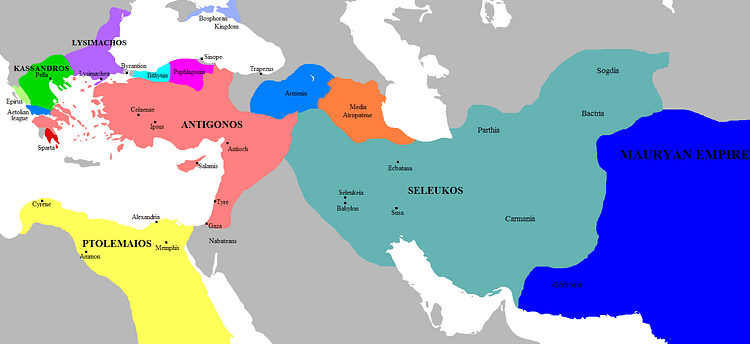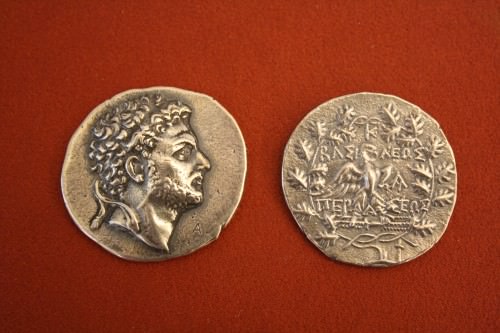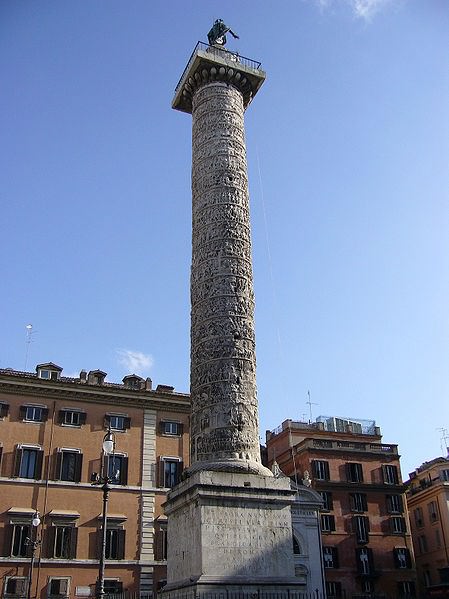Hellenistic Period › The Column of Marcus Aurelius » Origins and History
Articles and Definitions › Contents
- Hellenistic Period › Ancient History
- The Column of Marcus Aurelius › Antique Origins
Ancient civilizations › Historical places, and their characters
Hellenistic Period › Ancient History
Definition and Origins

The Hellenistic Period is a part of the Ancient Period for the European and Near Asian space. The use of this period is justified by the extent of the Hellenic culture in most of these areas, due to the Greek political presence especially in Asia after Alexander 's conquests, but also to a new wave of Greek colonization. In consequence, the Hellenistic Period is usually accepted to begin in 323 BC with Alexander's death and ends in 31 BC with the conquest of the last Hellenistic kingdom by Rome, the Lagid kingdom of Egypt. For the Asian part, we could lengthen it to 10 BC, when the last Indo-Greek kingdom was conquered by Indo-Sakas.
Politically, the Hellenistic Period is characterized by a division and a split from Alexander's former empire, with endless wars between the Diadochi and their successors. Thus the Hellenistic kingdoms weakened themselves and thus gradually created space for competing kingdoms, such as Pontus or Bactria. At the same time, Roman power was in exponential expansion, annihilating other political presence in Italy, and then the Carthaginian dominance of the Mediterranean in the three Punic Wars. At the end of the Hellenistic Period the young Roman empire had almost reached its maximum expansion, from Lusitania (modern Portugal) to Syria and from South- Britain to Egypt.
Politically, the Hellenistic Period is characterized by a division and a split from Alexander's former empire, with endless wars between the Diadochi and their successors. Thus the Hellenistic kingdoms weakened themselves and thus gradually created space for competing kingdoms, such as Pontus or Bactria. At the same time, Roman power was in exponential expansion, annihilating other political presence in Italy, and then the Carthaginian dominance of the Mediterranean in the three Punic Wars. At the end of the Hellenistic Period the young Roman empire had almost reached its maximum expansion, from Lusitania (modern Portugal) to Syria and from South- Britain to Egypt.
THE HELLENISTIC PERIOD IS CHARACTERIZED BY A SPLIT OF ALEXANDER'S FORMER EMPIRE, WITH ENDLESS WARS BETWEEN THE DIADOCHI AND THEIR SUCCESSORS.
Other general political evolution can be seen too: The Celts were shaken once more by a big wave of migration (from which arose among others the famous Galatians in Anatolia ). The growing pressure of the Celts' neighbours, though, especially from Germanic Tribes and the Romans, reduced their dominion drastically at the end of the period. In the endless northern steppes of Asia, nomad pressures continued in a similar way as before, Sarmatians pressuring Scythes and Yuezhei pressuring Sakas, who increased so their attacks against the Bactrian and then Indo-Greek kingdoms.
In general, some things characterized this period in opposition of the previous one: The model of the city-state which dominated before was replaced by the different kinds of kingdoms, with more centralized power. Moreso, it is the basic idea of administration which changed: It was no longer a matter of managing the civic affairs in the name of the community, but by delegation in the name of one personal authority. At the same time, mercenaries were more frequently used in Hellenistic armies, in order to face the military and technical evolution which greatly increased the cost for equip a civic army. The best example is the fame and the use of the Galatians by the Hellenistic kingdoms.

Macedonian Silver Tetradrachm
The Column of Marcus Aurelius › Antique Origins
Ancient Civilizations
The Column of Marcus Aurelius and Faustina which stands in Piazza Colonna in Rome is thought to have been erected by Commodus in memory of his father and mother sometime around 180 CE. The column was inspired by its more famous predecessor Trajan 's Column which was set up, also in Rome, in 113 CE. The column carries representations carved in high relief of the emperor's successful military campaigns against the Quadi across the Danube between 172 and 175 CE.

Column of Marcus Aurelius
The column presently stands 39 metres tall but a further 7 metres of the base structure remains underground, the lowest portion never having been excavated. Originally, there was also a statue - most probably of the emperor - on top of the column, increasing the overall height of the structure even further. This would account for the figure of 51.95 metres (or 175 Roman feet) mentioned in the 4th century CE Regionary Catalogues. The column is hollow and inside it a spiral staircase was built which once gave access to the upper viewing platform. The interior is entered through a doorway in the base on the Via del Corso side but is now closed to the public. It is thought that a temple to the deified emperor and his empress was originally situated close to the column.
THE DORIC COLUMN IS COVERED IN RELIEF CARVINGS IN 21 SPIRALS - EACH BEING SOME 130 CM IN HEIGHT.
The Doric column is more or less straight (only 14 cm wider at the base) and is covered in relief carvings in 21 spirals - each being some 130 cm in height- which depict the campaigns of Marcus Aurelius in the territories north of the Danube, first against the Marcomanni (172-3 CE) and then against the Sarmatians (174-5 CE). The narratives of the two campaigns are divided on the column by a figure of Victory who writes on a shield and the first begins from the base with troops crossing the Danube river. The vast majority of episodes are those from the battlefield but there are some interesting background scenes such as the emperor addressing his troops and even glimpses of the logistics and engineering feats performed in Roman warfare such as one depiction of troops crossing a pontoon bridge. The reliefs are typical of the style that would come to dominate Late Antiquity sculpture. There is an emphasis on frontal views with perspective achieved simply by having smaller figures in rows above the foreground and with figures rendered not quite in proportion, heads being too large and bodies being either too short or elongated, and with facial features minimised. Plaster casts of the reliefs can be viewed in the Museo della Civilità Romana in Rome.

Column of Marcus Aurelius
The column was often called the 'Centenaria' by locals which referred to the height of the column, immediate base and capital, which together measured 100 Roman feet (29.6 m). This is mentioned in the inscription on the column base. We are also informed that there was a dedicated procurator or caretaker responsible for the upkeep of the monument. Adrastus, a freedman, had actually requested in 193 CE that a hut be built near the column so that he could better fulfil his role as guardian. The request was granted and the hut built on public land suitably nearby.
Over the centuries the column has suffered, like most ancient monuments, the ravages, not only of weather, but also the changing of human needs and tastes. The scenes on the column were carved in much higher relief than on Trajan's Column and have consequently deteriorated much more due to weathering. The column has also suffered lightning strikes and earthquakes but, even worse, in the Middle Ages the valuable pins which held the various drums of the column in position were removed and consequently several have shifted dramatically over time.

Relief from the Column of Marcus Aurelius
The column was restored by Pope Sixtus the Fifth in 1589 CE as inscriptions on each side of the base relate. The pedestal was re-formed to account for the change in ground level and a bronze statue was also put back on the top of the column, although, this time, one of St. Paul. Some of the 'restoration' work was more questionable. There were originally, for example, sculptures projecting from the column about halfway up in four directions. These sculptures depicted conquered barbarians surrendering to Marcus Aurelius and three Victories with garlands, however, they were removed completely from the structure and they survive only in Renaissance-period drawings. These alterations and other repairs to damaged areas can be clearly seen today as they were filled with grey Proconnesian marble which contrasts starkly with the original fine white marble of this lasting monument to Roman militarism and vanity.
LICENSE:
Article based on information obtained from these sources:with permission from the Website Ancient History Encyclopedia
Content is available under License Creative Commons: Attribution-NonCommercial-ShareAlike 3.0 Unported. CC-BY-NC-SA License